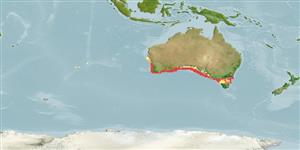Common names from other countries
分類 / Names
共通名の | 類義語 | Catalog of Fishes(部類, 種) | ITIS | CoL | WoRMS | Cloffa
Environment: milieu / climate zone / depth range / distribution range
生態学
海 底生の; 深さの範囲 70 - 490 m (Ref. 6390). Subtropical; 27°S - 41°S
Indo-Pacific: endemic to the southern waters of Australia, from Marrawah in northwestern Tasmania to latitude 27°S off Western Australia. This species has been confused with Platycephalus speculator until recently.
Length at first maturity / サイズ / 重さ / 年齢
Maturity: Lm 40.0, range 45 - ? cm
Max length : 70.0 cm TL オス/雌雄の選別がない; (Ref. 6390); 94.0 cm TL (female); 最大公表体重: 0.00 g; 最大記録サイズ: 20 年 (Ref. 6390)
Occurs on the continental shelf and upper slope (Ref. 9563). Feeds primarily on fish, crustaceans and squid (Ref. 6390). Probably forms aggregations by sex (Ref. 27192). Sold as fresh, chilled, or frozen fillets in the domestic market.
Life cycle and mating behavior
成熟 | 繁殖 | 放精 | 卵 | 生産力 | 幼生
Paxton, J.R., D.F. Hoese, G.R. Allen and J.E. Hanley, 1989. Pisces. Petromyzontidae to Carangidae. Zoological Catalogue of Australia, Vol. 7. Australian Government Publishing Service, Canberra, 665 p. (Ref. 7300)
CITES (Ref. 128078)
Not Evaluated
Human uses
水産業: 商業
より多くの情報
参考文献水産養殖水産養殖の紹介緊張遺伝子のElectrophoreses遺伝病気行列Mass conversion
協力者画像Stamps, Coins Misc.音シガテラ(食中毒の名前)速度泳ぐ 型式カマOtoliths脳視覚
用具
特記事項
XMLをダウンロードして下さい
インターネットの情報源
Estimates based on models
Preferred temperature (Ref.
115969): 12.7 - 15.8, mean 14.4 (based on 15 cells).
Phylogenetic diversity index (Ref.
82804): PD
50 = 0.5000 [Uniqueness, from 0.5 = low to 2.0 = high].
Bayesian length-weight: a=0.00525 (0.00246 - 0.01120), b=3.04 (2.85 - 3.23), in cm Total Length, based on LWR estimates for this (Sub)family-body shape (Ref.
93245).
栄養段階 (Ref.
69278): 4.0 ±0.59 se; based on food items.
回復力 (Ref.
120179): 低い, 4.5年~14年の倍増期間の最小個体群 (tm=4-6; tmax=20).
Fishing Vulnerability (Ref.
59153): Moderate to high vulnerability (53 of 100).
